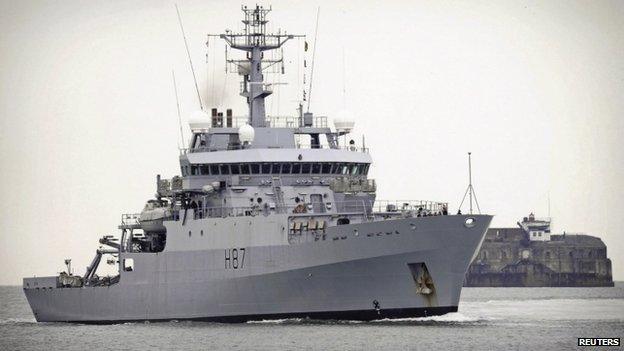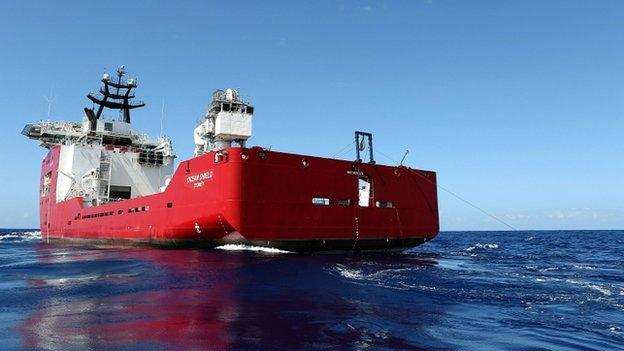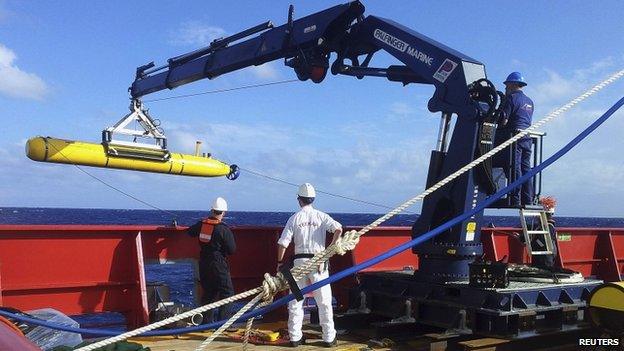Malaysia flight MH370: Pursuing those pulses
- Published

A towed ping locator can be lowered deep into the water to search for any signal from the flight recorder
The search for the missing Malaysia Airlines flight is focused on two areas of the Indian Ocean where possible "black box" signals have been detected. The BBC's Nick Childs looks at how reports are being investigated.
There are multiple cautions, caveats, and questions. But in a frustrating search that has produced very few clues, and still zero physical evidence of a possible crash location, the search teams have to take these reported acoustic contacts seriously as possible leads, not least because of the potential prize they could offer of dramatically narrowing the search area. Hence the redeployment of ships and aircraft to pursue them.
The reported contacts by the Chinese vessel Haixun 01 were the first to cause a stir.
The most intriguing element was the fact that the signal it apparently detected was on the frequency 37.5 kHz, consistent with the beacon on a black box.

Chinese state media reported that Chinese search teams had picked up electronic pulses
But some experts have questioned whether the listening equipment the Chinese appear to have been using would necessarily be able to isolate that frequency.
Also the equipment has been monitoring from just below the sea surface. Again, could it realistically pick up a signal from a beacon that has limited range itself, and could be up to 4,500m below the surface?
Pursuing the search
The search co-ordinators say they have despatched Royal Australian Air Force (RAAF) aircraft to help assess the contacts. The RAAF's maritime patrol aircraft can drop sonobuoys - also listening devices.
But possibly key to pursuing the search is the arrival of the UK Royal Navy survey ship HMS Echo.

British navy ship HMS Echo has more advanced technology for listening for any signal
It has more advanced listening equipment aboard, including a high-precision acoustic positioning system.
The drawback with all these capabilities, though, is that they operate from or near the surface.
Sophisticated


The best-equipped ship in this search is the Australian naval vessel Ocean Shield. But it has been pursuing a possible acoustic contact of its own some 300 nautical miles (560km) away from the Chinese contacts.
Very little is known about the details of that contact. But, again, experts say that the distance between this and the Chinese contacts make it unlikely that both could be connected to MH370.
The Ocean Shield has the specialised 'towed pinger locator' aboard, which - crucially - can be lowered deep into the ocean on 6,000m of cable to search for signals.

The Australian navy vessel Ocean Shield is seen dragging the towed ping locator
In addition, it has the Bluefin-21 autonomous underwater vehicle - essentially an underwater drone - which can also be programmed to dive deep into the ocean to search with sonar if a contact is deemed to be of sufficient interest.
Another asset about which little has been heard is the Royal Navy nuclear-powered submarine HMS Tireless, which it was announced had been sent to the search area. I am told it has been on task.
It cannot dive down to the seabed in this area of very deep ocean. But it can operate many hundreds of metres below the surface with its sophisticated sonars, including its own very sensitive towed array system which can listen from this depth.
Doubts
But the ocean is a notoriously difficult acoustic environment. It can play all sorts of tricks with sound propagation.
That fact, the size of the search area up to now (still some 216,000 sq km, or 84,000 sq miles), and the limited range of the signals from "black box" beacons, have all added to the doubts of sceptics that any of the searching vessels could, in effect, stumble on a contact without other clues.

The Ocean Shield is also carrying the Bluefin-21 autonomous underwater vehicle
The normal sequence is that other evidence, like a debris field, narrows the search area before underwater detection devices can be brought into play effectively.
There is a new urgency to all this. It is feared that the batteries running the beacons on the black boxes will start to run out from about now.
So the words of the chief search co-ordinator, retired Australian Air Chief Marshal Angus Houston, have been very measured.
These possible contacts amount to an important and encouraging lead, he says.
But they must be treated carefully. And, for now, they remain unverified.